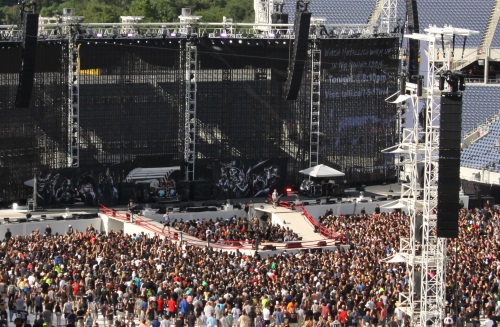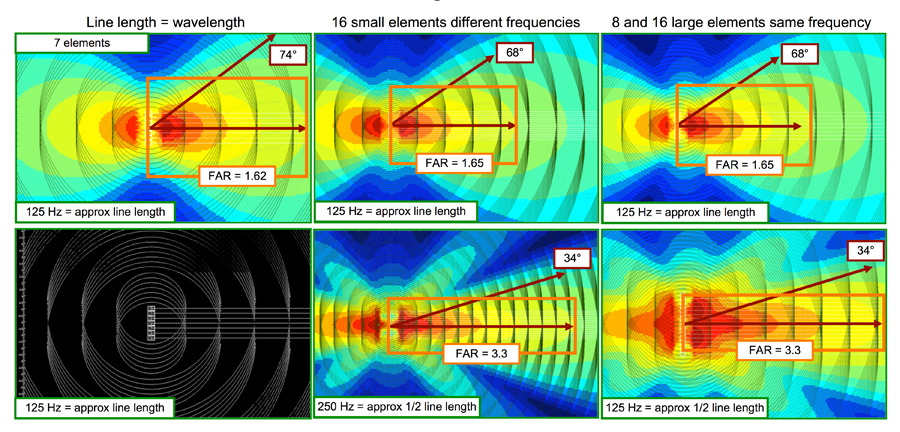
Let’s take a moment to consider exactly what line length does. We begin by noting that the beamwidth of a single loudspeaker approaches 90 degrees when the transmitted wavelength (λ) equals the radiating cone size. Lower frequencies are wider than 90 degrees and higher ones are narrower until the wavelengths are so small that lobing scatters the pattern.
A coupled line source also has a size-related directivity milestone: coverage is 72 degrees when the transmitted λ equals the line length, e.g., an array 2 meters long will be 72 degrees at 170 Hz. The coverage widens below and narrows proportionally above.
The narrowing is also frequency/wavelength-limited by lobing, in this case by the combing interaction caused by the element spacing.
Some notable conditions are attached to the 1λ = 72 degrees standard coverage. Line length equations assume omnidirectional sources, so the coverage numbers will shrink with directional elements. We also need enough quantity for the line shape to be fairly full of loudspeakers.
Think of the 1λ length as a spread of 360 degrees of phase offset over the elements. With just two elements, the sources are a full λ apart, causing a huge side lobe (0 degrees + 360 degrees). Three elements within the same length spaces them at 180-degree intervals, which should set off alarm bells. Five elements brings the spacing to 90-degree intervals, which can achieve the orderly chaos needed to cancel the side radiation.
Beyond this point the quantity has less impact on the cut-off frequency. Line lengths of 3 meters will have the same cut-off frequency (113 Hz) whether we fill it with 8, 12 or 16 elements. Line lengths of 1.35 meters, 2.7 meters, and 5.4 meters correspond to cut-off frequencies of 250 Hz, 125 Hz, and 63 Hz, respectively.
Primary features of line length:
• Standard attributes apply to omnidirectional sources.
• Nominal coverage is 72 degrees when line length = 1λ, 36 degrees when length = 2λ, and so on.
• Directional elements reduce the nominal coverage proportionally.
• Line must be effectively continuous (sufficient density to maintain coupling).
Angular reduction is proportional at frequencies above the 1λ length, i.e., we get 36 degrees when we double the length, or double the frequency. The narrowing continues with successive doublings. Simple proportionality does not hold below the 1λ frequency as the coverage approaches 360 degrees.
It’s easy to exaggerate the ramifications of line length as also often happens with coverage angle. The 1λ frequency is a convenient reference point but not something that stands out like a misaligned crossover. It’s not as if 72 degrees is the world’s greatest coverage angle. The frequencies below this marker widen gradually, not suddenly, so don’t be disappointed when adding that 16th box reduces the coverage all the way to 68 degrees.
Line length is decisive only in the very low end of these arrays, where omnidirectional elements are otherwise un-steered. As frequency rises and elements become directional, the line length extends the uncoupled/undefined (near field) area of the parallel pyramid. The extension varies with frequency, becoming steadily longer in the HF. This results in widespread spectral variance over angle and over distance.
It’s often believed that line length is a property exclusively relevant to the coupled line source (all boxes at 0 degrees). The coupled point source also has length, albeit in curved form. A few degrees of splay between boxes is negligible to omnidirectional elements, so the difference between a line and point source in the relevant range is not worth spending any time to analyze.
We can summarize the line length behavior by the Goldilocks method: too big, too small and “just right” (assuming 72 degrees is your target coverage angle). We have less than full control when λ is greater than line length, extra control when λ is less than line length, and just right control when λ equals line length (Figure 1).

